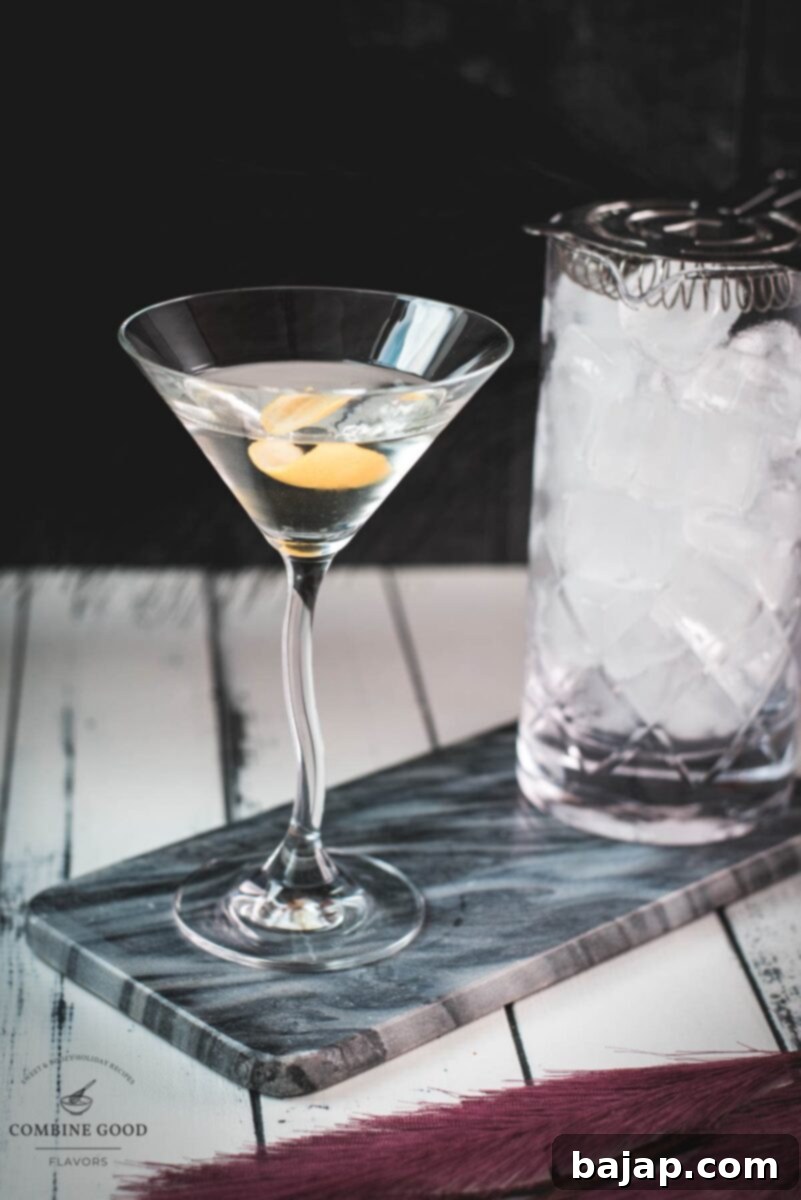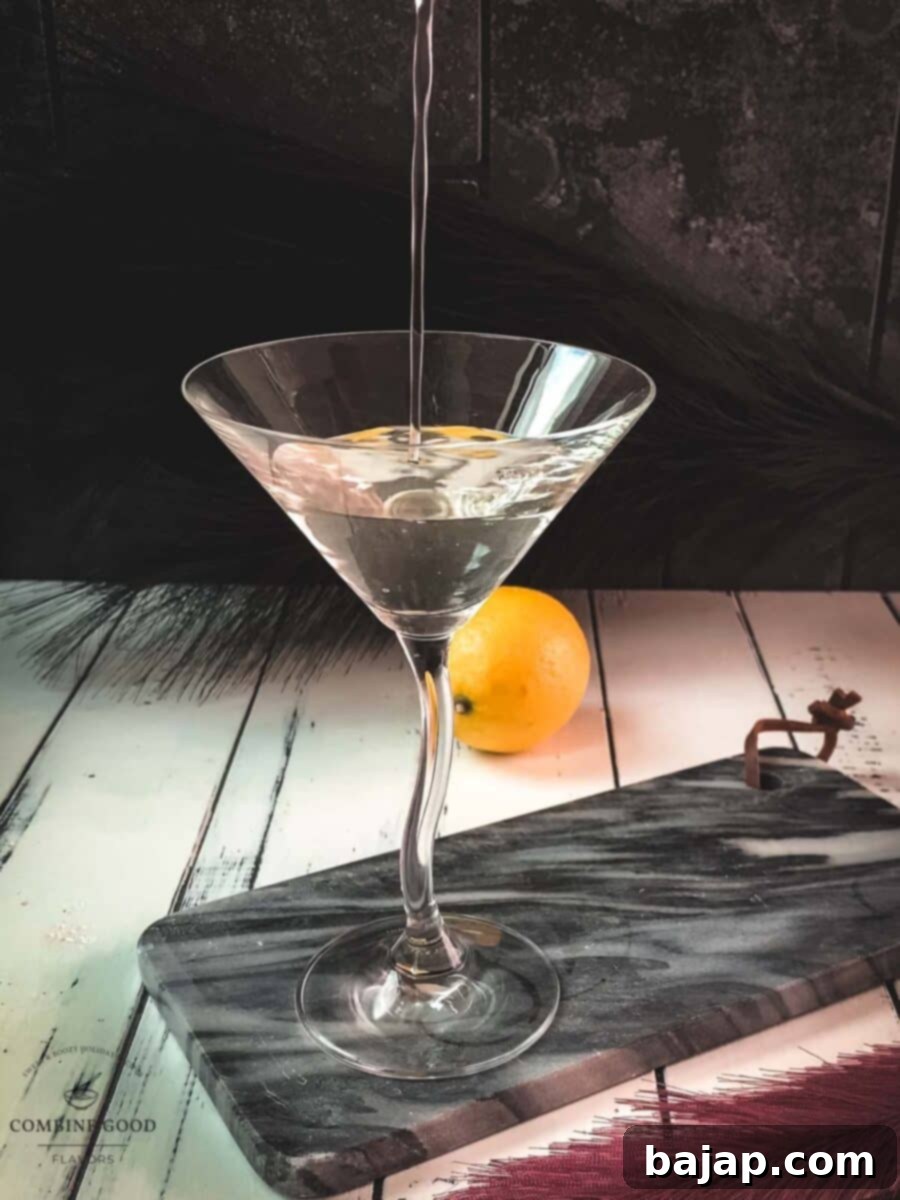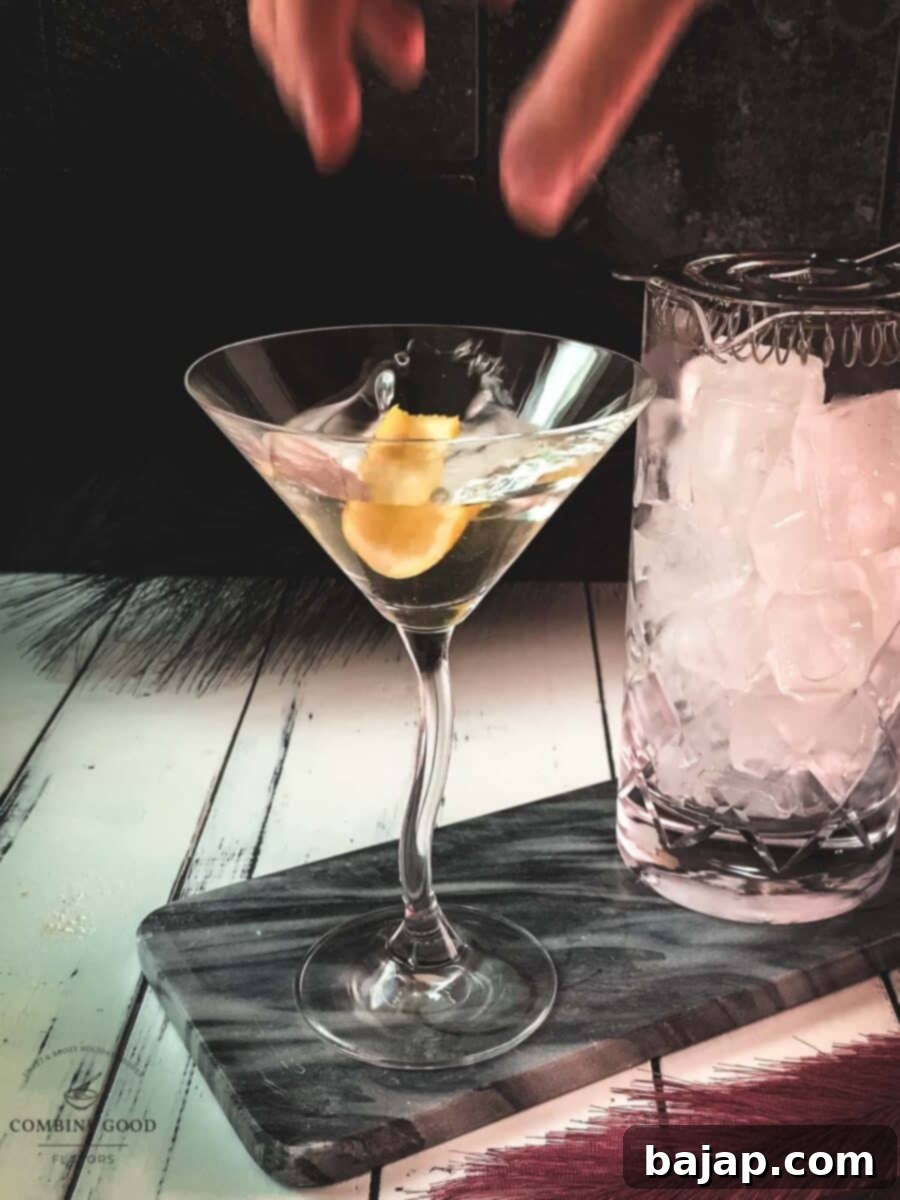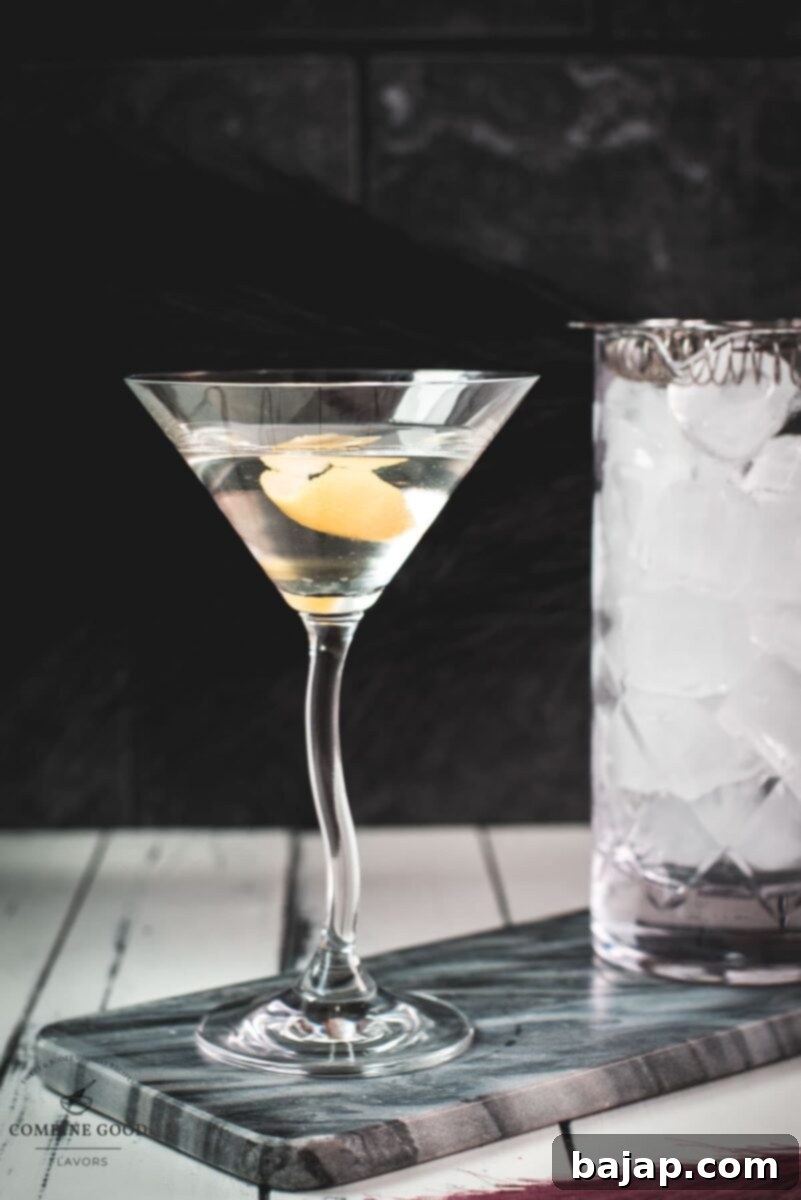Master the Classic Martini: Your Ultimate Guide to Perfect Gin & Vodka Martinis (Classic, Dry, Dirty)
Hello, my dear cocktail friend! As the year unfolds, there’s no better time to celebrate a true icon of mixology: the martini. This drink isn’t just a cocktail; it’s a statement of timeless elegance, a symbol of sophistication, and a staple at everything from casual gatherings to the most glamorous evenings. Simple in its core components yet rich in its potential variations, the martini holds a distinguished place in every cocktail enthusiast’s repertoire.

But how do you truly prepare the perfect martini? Is it stirred or shaken? What are the key distinctions between a classic martini, a vibrant dry martini, or a bold dirty martini? These questions are at the heart of martini mastery, and understanding the nuances is what elevates a good drink to a truly exceptional one.
In this comprehensive guide, I’ll not only unveil my go-to recipe for the quintessential classic martini, but we’ll also dive deep into these popular variations and the precise techniques that define them. While many purists steadfastly advocate for stirring in a mixing glass to achieve that crystal-clear appearance and velvety-smooth texture, there are indeed situations and preferences that embrace shaking for a slightly different texture and aeration. We’ll explore both schools of thought.
So, let’s embark on this delightful journey into the world of martinis! Grab your favorite gin or vodka, a sturdy stirring glass (or a shaker if that’s your preference), and a beautifully chilled glass. By the end of this post, you’ll possess not just the practical tools to craft a martini perfectly tailored to your taste, but also the rich knowledge to confidently impress your guests with its fascinating history and diverse variations. Cheers to raising a glass with a touch of unparalleled elegance!
🎥 Video: Crafting the Perfect Martini
🥘 Essential Ingredients for Your Martini
Crafting a superb martini begins with selecting high-quality ingredients. While the recipe seems simple, the impact of each component is profound. Here’s what you’ll need for a truly classic experience:
- Cubed Ice: Not just any ice, but good quality, solid cubed ice for your stirring glass. This is crucial for proper chilling and minimal dilution.
- Gin: The heart of a classic martini. While many excellent options exist, Plymouth Gin stands out as a top-tier choice. Its balanced, slightly sweeter, and more aromatic profile makes it incredibly versatile and a safe, delightful choice for anyone exploring classic gin cocktails. For those who prefer a drier, more juniper-forward profile, London Dry gins are also excellent.
- Dry Vermouth: Often underestimated, dry vermouth is the soulmate to gin in a martini. It adds herbaceous notes, a subtle sweetness, and a layer of complexity. Choose a good quality dry vermouth and remember to store it in the refrigerator after opening, as it is a fortified wine and will spoil.
- Garnish: The final flourish! A thin, elegant lemon zest twist provides a bright, aromatic lift, while a plump olive (or two!) adds a savory, briny counterpoint, especially appealing for those who lean towards a “dirty” style.
For precise measurements for a single serving, please refer to the detailed recipe card below.
🔪 Step-by-Step Instructions to Craft a Perfect Classic Martini
Follow these steps meticulously to achieve a perfectly chilled, smooth, and exquisitely balanced martini every time. The key is in the technique and the attention to detail.
Step 1: Prepare Your Base
Pour your chosen gin and dry vermouth into a chilled stirring glass. Begin by chilling your stirring glass and martini glass beforehand (either by filling them with ice water and letting them sit, or by placing them in the freezer). The chill of the stirring glass is paramount; it helps to maintain the martini’s crisp, smooth character and prevents excessive dilution, ensuring your drink stays cold longer. Use a jigger or measuring tool to ensure precise ratios.


Step 2: The Art of Stirring
Add fresh, solid ice to the stirring glass and gently stir the drink with a long bar spoon. The technique here is key: slide the spoon along the inner rim of the glass, creating a smooth, continuous, rotating movement of the ice cubes. This method ensures that the gin and vermouth are thoroughly chilled and perfectly integrated, achieving the desired silky texture without introducing air bubbles or over-dilution. Stir for about 20-30 seconds, or until the stirring glass becomes frosty to the touch.


Step 3: The Flawless Strain
Strain the cocktail into your pre-chilled martini glass. Place a julep strainer over the stirring glass to hold back the ice. For an extra layer of perfection, pour the martini through a fine mesh strainer as well. This double-straining step ensures your martini is impeccably smooth, free of any tiny ice shards, and boasts that pristine, crystal-clear appearance. The colder the glass, the better your martini will taste and hold its temperature.

Step 4: Garnish and Serve with Panache
Garnish your masterpiece and serve immediately. For a classic presentation, choose a thin slice of vibrant lemon zest. Express the oils over the drink by twisting it gently, then drop it in. Alternatively, for a savory touch, add one or two high-quality olives. Serve this timeless cocktail perfection right away to capture its optimal temperature and flavor. Enjoy every exquisite sip!

🍸 Exploring Martini Variations: Classic, Dry, and Dirty
The beauty of the martini lies in its adaptability. While seemingly simple, subtle adjustments to ratios and additions can completely transform the flavor profile, creating a martini for every palate and occasion. Let’s delve into the distinct characteristics of the most beloved martini variations, empowering you to confidently mix the perfect drink for any mood or guest.
1. The Classic Martini: The Quintessential Elixir
This is where it all began – the elegant, timeless, and utterly sophisticated foundation of the martini family. A traditional classic martini is typically made with gin (though vodka is a popular alternative for a vodka martini) and dry vermouth, meticulously stirred over ice until it reaches a perfectly chilled, silky consistency. It embodies balance and refined taste.
- The Ratio: Traditionally, a 2:1 or 3:1 ratio of gin to dry vermouth is standard. This ratio allows both spirits to express themselves harmoniously.
- The Garnish: A delicate lemon twist, expressed to release its fragrant oils, provides a bright, aromatic lift. Alternatively, a single, high-quality olive adds a subtle savory note.
- The Flavor: Balanced, smooth, and nuanced. The rich botanicals of the gin are beautifully complemented by the gentle herbal sweetness and subtle bitterness of the vermouth, creating a complex yet approachable flavor.
- Why You’ll Love It: It’s the ultimate expression of cocktail grace – classic, incredibly versatile, and always in impeccable style. It’s perfect for those who appreciate the subtleties of gin.
2. The Dry Martini: A Gin Lover’s Dream
For those who truly adore the bold, aromatic character of gin, the dry martini is your unwavering companion. This variation significantly reduces the amount of vermouth – sometimes to just a fleeting rinse of the glass or even a whispered mist – allowing the gin’s intricate botanicals to command center stage with minimal interruption.
- The Ratio: This can range from a dominant 5:1 gin to vermouth ratio, extending even further to just a ceremonial “wash” of vermouth in the glass, depending on how exquisitely dry you prefer your drink. Some even opt for no vermouth at all, which purists would argue isn’t truly a martini, but a glass of chilled gin!
- The Garnish: A crisp lemon twist is often favored to enhance the gin’s citrus notes, though a classic olive can still provide a welcome savory counterpoint.
- The Flavor: Exceptionally crisp, clean, and intensely gin-forward. The vermouth acts merely as a ghost, providing a whisper of herbal complexity rather than a pronounced flavor.
- Why You’ll Love It: It’s a no-nonsense homage to the majesty of gin, delivering a powerful and pure spirit experience.
3. The Dirty Martini: The Savory Sensation
Craving a martini with a distinctly savory edge? Look no further than the dirty martini, where a splash of olive brine artfully joins the party, transforming the cocktail into an irresistible, briny delight. This variation is a particular favorite among olive aficionados.
- The Ratio: While retaining a similar gin-to-vermouth ratio as a classic martini, the defining characteristic is the addition of ½ to 1 ounce of good quality olive brine, which imparts that signature “dirty” and salty taste. Adjust the amount of brine to your personal preference for saltiness.
- The Garnish: Always olives! The more the merrier. For an indulgent touch, consider blue cheese-stuffed olives, which add another layer of savory richness and a creamy texture.
- The Flavor: Boldly savory and wonderfully briny, the salty olive juice introduces a delightful punch of umami, creating a vibrant contrast with the gin and vermouth combination.
- Why You’ll Love It: It’s a martini that truly satisfies a craving, offering a unique blend of cocktail and gourmet bar snack all in one tantalizing glass.

🍸 Choosing Your Gin & Dry Vermouth: The Heart of Your Martini
The quality and character of your gin and dry vermouth are paramount in crafting an exceptional martini. These two ingredients form the very backbone of the drink, and understanding their individual profiles can help you tailor your martini to perfection.
When it comes to gin, the choices are vast. Plymouth Gin is a historical classic, celebrated for its unique, slightly sweeter, and earthier flavor profile with prominent citrus notes. Its softer character makes it incredibly versatile and a superb choice for a balanced martini. For those who prefer a more robust, juniper-forward experience, a traditional London Dry Gin like Tanqueray No. Ten is an excellent contender, offering bright citrus and spicy undertones that pair beautifully with a range of vermouths for a refreshingly complex sip. Other notable gins include Beefeater for a drier, spicier kick, or Hendrick’s for a cucumber and rose infused botanical journey, perfect for a more modern twist.
Equally important is your selection of dry vermouth. It’s not merely a supporting player; it’s a crucial component that adds depth and aromatic complexity. Lighter, more delicate options such as Dolin Dry Vermouth allow the gin’s botanicals to shine, offering subtle floral and herbal notes without overpowering the drink. If you seek a vermouth that contributes a bit more character, a more robust choice like Carpano Dry Vermouth can add a richer, more profound herbal and slightly bitter dimension. For enthusiasts of the dirty martini, a vermouth with a slightly more pronounced, savory profile like Noilly Prat harmonizes beautifully with the briny olive flavors. Remember, vermouth is a fortified wine and is perishable once opened. Always store it in the refrigerator and aim to use it within a few months to ensure optimal freshness and flavor.
Whether your preference is for a classic gin and lemon twist pairing, a dramatically dry martini, or an adventurous dirty rendition with blue cheese olives, experimenting with different gin and vermouth combinations is an enjoyable journey of discovery. Your perfect martini awaits, a testament to thoughtful selection and expert preparation.
🍽 Essential Equipment for Martini Making
Having the right tools is crucial for crafting a professional-quality martini at home. These pieces of equipment ensure precision, proper chilling, and a smooth finish.
- Measuring Tools / Jigger: For accurate measurement of gin and vermouth, ensuring the perfect balance of flavors.
- Stirring Glass: A thick-walled glass specifically designed for stirring cocktails. Its robust construction helps maintain a consistent cold temperature.
- Bar Spoon: A long, twisted spoon perfect for stirring drinks smoothly and elegantly without introducing too much air.
- Julep Strainer: Used to hold back ice in the stirring glass while pouring the cocktail into your chilled martini glass.
- Fine Strainer: An additional strainer (often a small tea strainer) used for double-straining to catch any tiny ice shards or botanical bits, ensuring a perfectly smooth martini.
- Cocktail Glass (Martini Glass): The iconic vessel for your martini. Always ensure it’s pre-chilled for the best experience.
- Sharp Knife & Cutting Board: Essential for preparing garnishes like lemon twists or olives with precision and safety.

💭 Top Tips for Martini Perfection
- Master the Stirring Technique for Crystal Clarity: The art of stirring is paramount for a traditional martini. When stirring your gin and vermouth in a robust stirring glass, ensure you use a long bar spoon. Glide it smoothly along the inner side of the glass, allowing the ice cubes to rotate gently. This technique achieves perfect chilling and dilution without introducing air bubbles, preserving the drink’s pristine clarity and velvety mouthfeel. Aim for 20-30 seconds of consistent stirring.
- Double-Strain for an Ultra-Smooth Finish: For the ultimate refined martini, employ a double-straining method. First, use a julep strainer (or a Hawthorne strainer) over your stirring glass to hold back the larger ice cubes. Then, pour the cocktail through a fine mesh strainer (like a small tea strainer) directly into your chilled martini glass. This meticulous extra step catches any tiny ice shards or small botanical particles, ensuring your martini is flawlessly smooth, sparkling clear, and exquisitely elegant in both appearance and texture.
- Always Chill Your Glassware: A warm glass will instantly diminish the enjoyment of your perfectly chilled martini. Always pre-chill your martini glasses in the freezer for at least 15-20 minutes, or fill them with ice water while you prepare the cocktail and discard the water just before straining. This ensures your martini stays cold and crisp from the first sip to the last.
- Fresh Garnishes Make a Difference: Whether you choose a lemon twist or olives, ensure your garnishes are fresh and of high quality. For a lemon twist, use a sharp vegetable peeler or knife to get a clean strip of zest, avoiding the bitter white pith. Express the oils by twisting it over the drink before dropping it in. For olives, opt for premium, brine-packed varieties, and consider stuffing them with blue cheese for an extra kick in a dirty martini.
Other Martini-Inspired Recipes for You to Try
If you’ve enjoyed mastering the classic martini, you might love exploring these other delightful martini-style concoctions:
- Cranberry Peppermint Martini: A festive and refreshing twist perfect for holidays.
- Watermelon Martini: A sweet and juicy cocktail, ideal for warmer days.
- National Martini Day {roundup}: A collection of diverse martini recipes for every taste.
- Limoncello Martini with Elderflower Syrup: A bright, floral, and citrusy delight.
- Raspberry Lemon Drop Martini Recipe: A vibrant, sweet-tart, and fruity experience.
- Limoncello Martini with Lemon Juice {shaken}: A zesty and invigorating shaken variation.
- How to make a Martinez: Explore the fascinating predecessor to the modern martini.
If you embark on making this classic martini recipe, please let me know how much you enjoyed it by leaving a ★★★★★ star rating and a comment below. Your feedback would be absolutely awesome! You can also sign up for our Newsletter to receive delicious homemade recipes weekly, or follow me on Pinterest or Instagram and share your creation with me. Just tag me @combinegoodflavors and use the hashtag #combinegoodflavors, so I don’t miss your fantastic work!
📖 Recipe: The Perfect Classic Martini

Master the Classic Martini
Nora
Prevent your screen from going dark
Save Recipe
Saved!
Pin Recipe
5 minutes
5 minutes
Alcoholic beverage, Cocktails
American
1
Serving
126
kcal
Equipment
-
Measuring tools / Jigger
-
Stirring glass
-
Bar spoon
-
Julep strainer
-
Fine-strainer
-
Cocktail Glass
-
Sharp knife & cutting board
1
Serving
126
kcal
Ingredients
-
1 ¾
oz
Gin
Plymouth Gin is a top-tier option -
½
oz
Dry Vermouth -
Cubed ice
for the stirring glass -
Lemon zest
or Olive for garnish
Instructions
-
Pour 1 ¾ oz Gin and ½ oz Dry Vermouth into a chilled stirring glass.1 ¾ oz Gin,
½ oz Dry Vermouth -
Add Cubed ice and stir gently with a bar spoon. Slide the spoon along the rim of the glass to create a smooth, rotating movement of the ice cubes, ensuring the drink is chilled without over-dilution.Cubed ice
-
Strain the cocktail into a chilled glass. Use a Julep strainer and fine strainer for a perfectly silky finish.
-
Garnish with a slice of Lemon zest for brightness or a classic olive, and serve right awayLemon zest
Never miss a recipe!
Sign up and let me spoil you weekly with a delicious homemade recipe!
classic martini, cocktail with gin, cocktail with vermouth, Martini
Like this recipe?
Mention @combinegoodflavors or tag #combinegoodflavors!
Nutrition values are estimates only, using online calculators. Please verify using your own data.
Serving:
1
Serving
|
Calories:
126
kcal
|
Carbohydrates:
1
g
|
Protein:
0.01
g
|
Sodium:
1
mg
|
Potassium:
1
mg
|
Iron:
0.02
mg

⛑️ Important Food Safety Guidelines
While martinis are all about enjoyment, adhering to basic food safety principles is always a good practice, especially when handling ingredients and equipment:
- Maintain Cleanliness: Always wash your hands thoroughly with soap and water before and after handling any food or drink ingredients. Ensure all bar tools, stirring glasses, and cocktail glasses are impeccably clean.
- Ingredient Freshness: As vermouth is a fortified wine, it can spoil once opened. Store it in the refrigerator and use it within a few months for optimal flavor and safety. Fresh garnishes (lemons, olives) should also be clean and fresh.
- Ice Safety: Use fresh, clean ice made from potable water. Never reuse ice that has been exposed to other foods or hands.
- Glassware Handling: Handle glassware carefully to avoid breakage. If a glass breaks, dispose of it safely and ensure no glass shards remain in your work area or ingredients.
- Avoid Cross-Contamination: Though less critical with cocktails than with raw meats, it’s good practice to use separate cutting boards and knives for garnishes if you’re also preparing other foods.
- Responsible Consumption: While not a food safety point in the traditional sense, always consume alcoholic beverages responsibly and in moderation.
For further comprehensive information on safe food handling, always check reputable sources such as Safe Food Handling – FDA.
